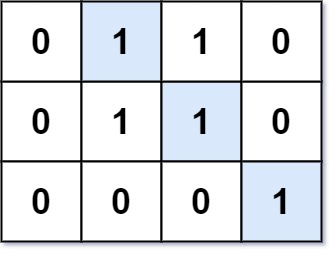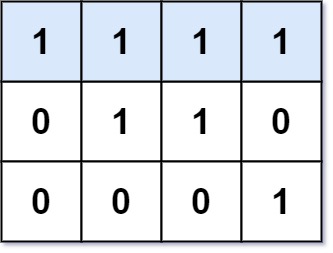LeetCode Link: https://leetcode.com/problems/longest-line-of-consecutive-one-in-matrix/
Language: C#
Problem Statement
Given an m x n binary matrix mat, return the length of the longest line of consecutive one in the matrix.
The line could be horizontal, vertical, diagonal, or anti-diagonal.
Examples
Example 1:

Input: mat = [[0,1,1,0],[0,1,1,0],[0,0,0,1]]
Output: 3
Example 2:

Input: mat = [[1,1,1,1],[0,1,1,0],[0,0,0,1]]
Output: 4
Constraints
- m == mat.length
- n == mat[i].length
- 1 <= m, n <= 104
- 1 <= m * n <= 104
- mat[i][j] is either 0 or 1.
Solution
public class Solution
{
public int LongestLine(int[][] mat)
{
var copy = new int[mat.Length][][];
int max = 0;
for (int i=0; i<mat.Length; i++)
{
copy[i] = new int[mat[i].Length][];
for(int j=0; j<mat[i].Length; j++)
{
copy[i][j] = new int[4];
if (mat[i][j] == 1)
{
copy[i][j][0] = 1;
copy[i][j][1] = 1;
copy[i][j][2] = 1;
copy[i][j][3] = 1;
var val = SetMaxLen(copy, i, j);
if (val > max)
{
max = val;
}
}
}
}
return max;
}
private int SetMaxLen(int[][][] mat,int i, int j)
{
int max = 1;
int val = 0;
if (i-1 >= 0)
{
val = mat[i-1][j][0] + 1;
mat[i][j][0] = val;
if (val > max)
{
max = val;
}
}
if (j-1 >= 0)
{
val = mat[i][j-1][1] + 1;
mat[i][j][1] = val;
if (val > max)
{
max = val;
}
}
if (i-1 >= 0 && j-1 >= 0)
{
val = mat[i-1][j-1][2] + 1;
mat[i][j][2] = val;
if (val > max)
{
max = val;
}
}
if (i-1 >= 0 && j+1 < mat[i].Length)
{
val = mat[i-1][j+1][3] + 1;
mat[i][j][3] = val;
if (val > max)
{
max = val;
}
}
return max;
}
}
Complexity
Time Complexity: O(mn)
Space Complexity: O(mn)